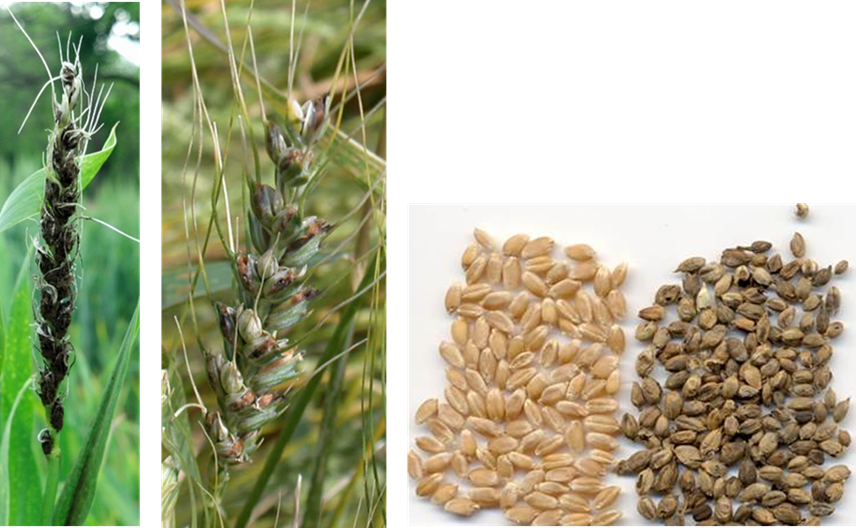This article was written by Dr. Bob Hunger, Extension Wheat Pathologist
I thought my 5-June update would be my last, but two samples/reports have come in that are prompting another update. One of these reports was wheat kernels with darkened-colored germ ends with the dark discoloration moving toward the middle of the seed and into the crease. This is indicative of black point (Figure 1; photo on the left), which is a discoloration of the seed (typically the germ end of the seed) resulting from either infection by a number of different fungi that typically are saprophytes (living on dead tissue) but can occasionally parasitize living tissue, or from a combination of abiotic (environmental) conditions that promote the discoloration without the presence of an organism. Often black point occurs when freeze damage has occurred, or harvest was delayed and dead tissue in the heads has been heavily colonized by fungi that cause sooty mold (Figure 1; photo on the right). Black point in wheat grain can be a grading factor as the discoloration can result in black flecks in flour milled from such grain. Additionally, if used as seed wheat, kernels with black point can have reduce germination resulting in a lower seedling emergence. Hence, if wheat showing black point is to be used as seed wheat, it is imperative to check the germination of that seed and to use a seed treatment that controls seed and seedling rots.

A second notable occurrence has been the report of wheat infested with common bunt/stinking smut. This disease should not be confused with loose smut. Loose smut is readily identified in the field as wheat is heading, and is characterized by heads with loose black spores (Figure 2; photo on the left). There is a big difference between loose smut and common bunt/stinking smut. Wind moves spores of the loose smut fungus to healthy wheat heads where they infect the developing seed at about the same time that flowering occurs. Hence, the loose smut fungus is inside of that seed. If the wheat is sold for flour there is no problem. However, if that infected seed is used as seed wheat the next fall, then the loose smut fungus will grow within the seedling and plant that emerges from that infected seed. Then at heading, instead of a normal head emerging a head filled with the black, loose smut spores emerges. In contrast to loose smut, common bunt/stinking smut produces ‘bunt balls’ in wheat heads (Figure 2; middle photo and photo to the right), which break and spread spores onto healthy wheat kernels as well as into the soil in the field. Hence, spores of the common bunt fungus survive on wheat kernels or in the soil and not inside of seed as is the case with loose smut. In the fall when wheat germinates, the common bunt spores also germinate and infect the young seedling. The fungus then grows with the plant, and as heading occurs and the wheat senesces, bunt balls are formed rather than wheat kernels. Another difference between these two smuts is that no odor is associated with loose smut, whereas a strong musty/fishy odor is associated with common bunt, especially if there is a bad infestation.

Recently I have received reports and a sample of wheat grain heavily infested with common bunt/stinking smut. The wheat kernels appear to have blackened tips (Figure 3; top left and top right photos), but in contrast to black tip (Figure 1) where the germ end is darkened, in this case the brush end of the seed is darkened. This blackening of the brush end is caused by thousands of common bunt/stinking smut spores being trapped in the brush (Figure 3; bottom photo). I am bringing this to your attention because although both loose smut and common bunt/stinking smut can create significant problems, both are readily controlled by the use of an appropriate seed treatment. Many such treatments are available. Some are for insects, some are for bunts and smuts, some are for root rots, and many are for a combination of wheat insect pests and wheat diseases. A good starting point as a guide for an appropriate seed treatment is the table on pages 262-263 in the 2020 OSU Extension Agents’ Handbook of Insect, Plant Disease, and Weed Control (OCES publication E-832) where many (but not all) of the more common seed treatments are listed. It may not be necessary to plant treated wheat seed every year to manage loose smut and common bunt/stinking smut, but it is much better to manage them preventatively rather than wait until there is a severe outbreak of either one in a field.
